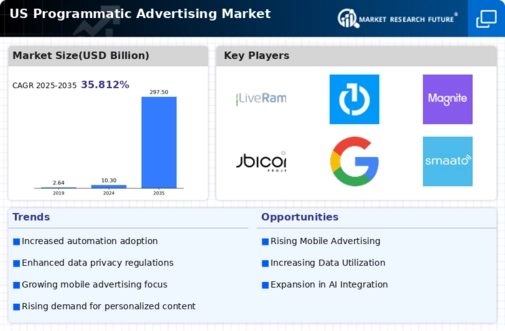The competitive insights of the US Programmatic Advertising Market highlight the dynamic and rapidly evolving landscape where advertisers leverage automated technology for targeted ad placements across various digital platforms. This market is characterized by its reliance on data-driven strategies, allowing advertisers to optimize their campaigns in real time and maximize their return on investment. With the increasing adoption of artificial intelligence and machine learning, the market is seeing shifts in how advertisements are bought and sold, emphasizing efficiency and effectiveness.
Key players in this space are investing heavily in technology enhancements and partnerships to build stronger, more integrated ecosystems that cater to the evolving demands of marketers and consumers alike.
Amazon has established a strong presence in the US Programmatic Advertising Market, leveraging its expansive retail ecosystem to enhance its advertising capabilities. The company's rich trove of first-party consumer data allows it to create highly targeted advertisements tailored to individual shopping behaviors and preferences. This data-driven approach enables Amazon to offer unique ad solutions that seamlessly integrate into its retail channels, providing advertisers with access to a vast audience.
The strength of Amazon lies not only in its user base but also in its innovative tools and technologies, which empower advertisers to manage their campaigns effectively and gain insights that foster better decision-making. With a focus on driving conversions and sales through its advertising solutions, Amazon continues to enhance its offerings, strengthening its position in the competitive market.
LiveRamp operates as another formidable player in the US Programmatic Advertising Market, specializing in data connectivity and identity resolution services. The company provides a platform that enables marketers to access, manage, and activate their data across various advertising ecosystems, enhancing the ability to reach target audiences effectively. LiveRamp's key strengths include its extensive partnerships with publishers, media companies, and demand-side platforms, which ensure a broad market presence and increased opportunities for advertisers.
The company's focus on privacy and compliance is also significant, as it helps clients navigate the complexities of data usage regulations. Recent mergers and acquisitions have further bolstered LiveRamp's capabilities, allowing it to expand its service offerings and maintain a competitive edge in the market. With a commitment to providing actionable insights and scalable solutions, LiveRamp plays a crucial role in shaping programmatic advertising strategies for its clients in the US.






















